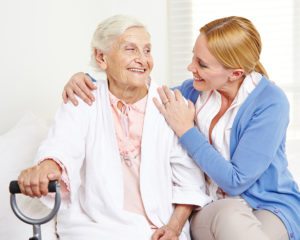Home Care-Helping your Senior Adapt to Oxygen Therapy

Caregiver in Bay Shore NY: Helping your Senior Adapt to Oxygen Therapy
If your senior has recently received a subscription for and started using oxygen therapy, they may feel a sense of loss. Their mind wanders to how they will travel, remain sociable, and concern mounts about how they will appear with an oxygen tank trailing behind them, or slung across their shoulder, and a cannula placed in their nose. Help them adapt to this new stage of their life by reminding them of all the benefits this therapy brings and the many ways society has adapted to this changing landscape.
Benefits
As COPD gets worse, the amount of oxygen carried from the lungs through the blood to organs, muscles, and cells diminishes, leaving vital body parts unable to function at their peak and carbon dioxide building up in the blood. Chronic fatigue is a common occurrence as well as shortness of breath. In addition to lessening these symptoms and improving their overall quality of life, oxygen therapy reduces the chance of heart failure and prolongs life. Those using oxygen therapy 18 hours or more a day double their survival rate over those not using any at all. Oxygen therapy has changed dramatically since its advent over 50 years ago. The 20-pound cylinders have morphed into small, lightweight liquid oxygen systems and portable oxygen concentrators. The technological advances have allowed patients to remain active and engaged and no longer limited to staying within a certain radius of their homes.
The Schedule
It’s important that your senior sticks to the recommended schedule for oxygen intake. They may have been subscribed oxygen only when sleeping, which includes every time they take a nap as well. If they’ve been prescribed oxygen at all times, they will require at least 15 hours per day.
Travel
The US Department of Transportation requires all U.S. air carriers to allow passengers to bring DOT-approved portable oxygen concentrators on flights within the U.S. or flights departing from or returning to the U.S. Be sure to check on the specific approved portable oxygen system—smaller and lighter than the home oxygen systems—for each specific airline. Your parent will also require a written form from their physician stating that they require oxygen and are fit for travel as well as a prescription for oxygen. In addition, the FAA requires the battery time to cover 150 percent of the flight time, whether your parent is using it all the time or not.
Home Care Provider
Your loved-one can have a wonderful quality of life, despite and because of oxygen therapy. As COPD progresses, they will need help with everyday activities of living. Consider the assistance of a home care provider who understands the specific needs of someone suffering from this disease and offers both care and companionship as your parent traverses through their elderly years.
If you or an aging loved-one is considering hiring a caregiver in Bay Shore, NY, please contact the caring staff at Family First Home Companions.
Serving all of Long Island. Call today: (631) 319-3961
Resources
Traveling with Oxygen on a Plane
Home Oxygen Therapy
Short History
Benefits of Oxygen Therapy
- Caregiver of the Month: Kathy - April 8, 2022
- Preventing Colds and Flu in Springtime - March 2, 2022
- Caregiver of The Month: Jacqueline B - February 21, 2022
